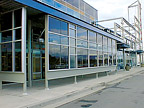
Patrons of the Regal Cinemas Spokane Valley 12 in Spokane, for example, entered the theater by an unprotected concrete walkway that, at times, became a virtual wind tunnel. Blowing rain, snow, or freezing temperatures often made these conditions more unpleasant. It also made the surface area slippery on occasion if snow stuck to the concrete surface or an icy surface formed before salt could be applied or the snow shoveled.
Theater management knew they had a problem keeping customers warm, especially during the winter months. To solve this problem, they contacted local Space-Ray dealer Tom Rissman of Space-Ray Northwest.
Lines Aren't Cool
Located within the Spokane Valley Shopping Center in Spokane, the standalone 50,000-sq-ft Regal Cinemas has 12 screens, each with a seating capacity of 375 patrons. Total seating capacity of the theater is 4,500 patrons.The one-story steel structure has metal and glass sides with a flat metal built-up roof. It was built in August 1997. Approximately 100 employees work at the theater.
When confronted with the problem of how to make movie patrons more comfortable before entering the theater, Rissman recommended to theater management the use of infrared gas heaters that are specifically designed for spot heating applications. The heaters would be placed in a 40-ft-long, semi-glass, enclosed structure located adjacent to the theater entrance. This, he reasoned, would keep the wind, rain, and snow out. Space-Ray Northwest designed the system and served as a mechanical contractor.
Rissman contacted the manufacturers of the heaters, Space-Ray, located in Charlotte, NC, for a free spot heat calculation to determine the ideal location and the capacity of the heaters. Two Space-Ray® LTU75 unitized low-intensity infrared gas heaters, each 17-ft long with a 75,000-Btuh heating capacity, were specified. The heaters were suspended from a metal awning 10 ft above the concrete walkway for spot heating. An on/off switch inside the theater controls the operation of the heater that allows the heaters to be used only when required.
James Hensen, the theater's general manager, said he is very pleased with how well the units heat the area, the people in line, and the concrete surface. "The heaters make a big difference to the comfort of my customers," he said.
Since installing the heaters, shoveling under the enclosed structure is no longer necessary. Thanks to the efficiency of the radiant heat, snow or ice melts within minutes. Patron safety is also enhanced due to the dry conditions under the surface.
Radiating Warmth
Bob Genisol, vice president of sales and marketing for Space-Ray, added that for spot or area heating projects such as Spokane Cinema, project U-tube heaters are recommended. "Straight tubes are typically always hotter at the burner end than at the exhaust end; therefore, we normally utilize the U-tube heaters at lower mounting heights when ultimate customer comfort and satisfaction is desired," said Genisol.Unlike forced air heating that works from the top down, infrared gas heat works from the bottom up, warming people and surfaces first for optimum comfort in addition to the direct radiant warmth from the heaters.
In this case, the technology has definitely been a box office hit. "This makes the movie experience that much better," noted Rissman. "Patrons are comfortable entering the theater rather than feeling cold or wet." ES
